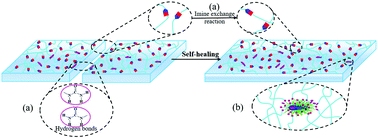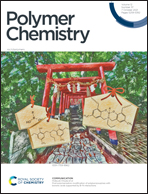Surface modified halloysite nanotube enhanced imine-based epoxy composites with high self-healing efficiency and excellent mechanical properties†
Abstract
Self-healing materials with high self-healing efficiency and excellent mechanical properties are desired for practical applications. Herein, imine-based epoxy composites enhanced by surface modified halloysite nanotubes (SiUr@HNTs) were fabricated. According to DSC curves, epoxy composites with 3 wt% of SiUr@HNTs have an excellent cure state. The addition of 3 wt% of SiUr@HNTs not only gives a certain fluidity to the composites to improve the self-healing performance (the tensile strength can restore to 7.10 MPa and the self-healing efficiency can reach 99.8%), but SiUr@HNTs can also be used as a mechanical enhancer to enhance the mechanical properties (the tensile strength increases from 5.16 MPa to 7.12 MPa). In addition, the epoxy composites can withstand large stretching and a weight of more than 400 g after ex situ self-healing. Besides, the epoxy composites have great thermal stability and solvent resistance. In general, this work proposed a method to improve the mechanical properties of self-healing materials, which is promising in the development of high-strength self-healing composite materials.



 Please wait while we load your content...
Please wait while we load your content...